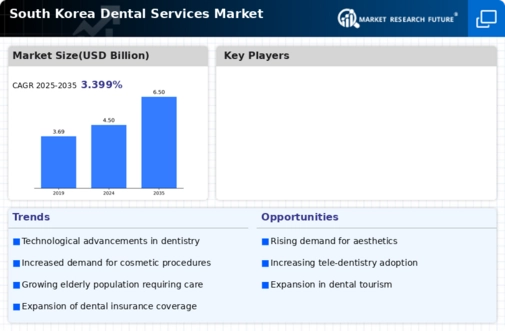Rising Health Awareness
There appears to be a growing awareness of oral health among the South Korean population, which is positively influencing the dental services market. Educational campaigns and public health initiatives have emphasized the importance of maintaining good oral hygiene, leading to an increase in regular dental check-ups. Recent surveys indicate that nearly 70% of South Koreans now visit a dentist at least once a year, a notable increase from previous years. This heightened awareness is likely to drive demand for preventive services, such as cleanings and check-ups, as well as treatments for dental diseases. Furthermore, the correlation between oral health and overall health is becoming more recognized, suggesting that the dental services market may continue to expand as individuals prioritize their health and well-being.
Growing Aging Population
The increasing aging population in South Korea is a pivotal driver for the dental services market. As individuals age, they often experience a higher prevalence of dental issues, necessitating more frequent dental visits. According to recent statistics, approximately 15% of the population is aged 65 and older, a figure projected to rise significantly in the coming years. This demographic shift is likely to lead to an increased demand for various dental services, including restorative and preventive care. Moreover, older adults tend to retain their natural teeth longer, which may result in a greater need for specialized dental treatments. Consequently, dental practices may need to adapt their services to cater to the unique needs of this demographic, thereby expanding their offerings within the dental services market.
Increased Disposable Income
The rise in disposable income among South Koreans is likely to have a substantial impact on the dental services market. As economic conditions improve, individuals are more inclined to invest in their oral health and aesthetic dental procedures. Recent data suggests that household disposable income has increased by approximately 5% annually, allowing more people to afford dental services that were previously considered luxury items. This trend may lead to a surge in demand for cosmetic dentistry, orthodontics, and other elective procedures. Additionally, as consumers become more willing to spend on dental care, dental practices may experience growth in revenue, prompting them to expand their service offerings and improve patient experiences within the dental services market.
Government Initiatives and Policies
Government initiatives aimed at improving public health are playing a significant role in shaping the dental services market. Policies that promote preventive care and subsidize dental treatments for low-income families are likely to increase access to dental services. Recent government reports indicate that funding for dental health programs has increased by 10% over the past year, reflecting a commitment to enhancing oral health across the population. These initiatives may encourage more individuals to seek dental care, thereby driving demand for various services. Furthermore, as the government continues to prioritize oral health, dental practices may find new opportunities for collaboration and funding, ultimately contributing to the growth of the dental services market.
Technological Integration in Dental Practices
The integration of advanced technologies in dental practices is transforming the dental services market in South Korea. Innovations such as digital imaging, 3D printing, and tele-dentistry are enhancing the efficiency and effectiveness of dental treatments. For instance, the use of digital impressions can significantly reduce the time required for procedures, improving patient satisfaction. Moreover, the market for dental technology is expected to grow at a CAGR of approximately 8% over the next five years, indicating a robust trend towards modernization. As dental practices adopt these technologies, they may attract a broader clientele, including tech-savvy younger generations who seek innovative solutions for their dental needs. This technological evolution is likely to play a crucial role in shaping the future landscape of the dental services market.











Leave a Comment